Ibon Inner Volcano Crater Lake
Curious result of plate tectonics
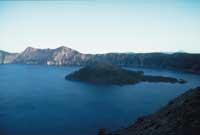
We all know the California earthquake, but we have barely heard of Oregon volcanoes. In Oregon, on a map, we will see it over California, embracing 251,470 km2, that is, twelve times larger than Euskal Herria. It should be noted that 52.4% of this area is in the hands of the federal government, while 44% is covered by conifer plantations.
In the
case of volcanoes, we must mention the volcanic mountains of Cascade Range, or the "suppressive mountains", saying in the visual way of doctor Jean Etxepare. This Cascade Range has a length of 1,000 km, from San Francisco to 325 km north and ending in the interior of Canada, whose highest peak is Mount Rainier (4,392 m), which is actually an off-mountain and located in the center of a national park.
The "soft mountains" of
Cascade Range have had a very complex geological history. As we know, the Earth's surface is dynamic and consists of tectonic plates that move slowly. The contact differences between these plates are areas of intense geological activity, often excessively violent. The Cascade Range volcanoes are the result of the collision between two of these tectonic plates, the San Juan de Fuca plate and the American plate. Pushing one against the other, these plates form a subduction space in which one plate undergoes the other. Thus, the surface light material of the Juan de Fuca plate melts when subjected to hot depths of the terrestrial mantle. This cast material moves from the North American plate and finally emerges forming the Cascade Range volcanoes. For example, 420,000 years ago Mount Mazama began to form.
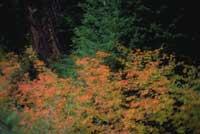
The protagonist of this work, the Crater Lake, is a deep set of waters, sweet and light, located in the caldera of a volcano extinct long ago, the waste of the crater of this prehistoric volcano Mazama. According to geologists, 7,700 years ago there was a cataclymatic eruption, in which the immense cone of the summit of mount Mazama of 3,660 m was emptied for three or four days, forming a boiler of 8 km of width and 1,220 m of depth. Since then, annual snowfall filled the caldera and finally formed a 589 m deep lake, the second in North America in depth and the seventh in the world. The strong lava cliffs surrounding the lake reach between 150 and 610 m above the almost vertical surface.
There are no rivers that go to the lake or those that come from the lake. The volume of water by evaporation and the accumulated by rain and snow are very balanced, so that the water level of the lake hardly varies from year to year.
On the surface the lake has 52 km2 and is almost circular. But the really surprising thing is its spicy blue color. This color is a consequence of two of its characteristics. On the one hand, the great depth. On the other hand, there is a great luminosity of the lake, since the water does not have dissolved organic materials or minerals, so the solar rays can reach depths greater than anywhere else. Light is absorbed in colors as it passes through water. Before red and then orange, velatory and green. The last to aspire are blue. And only the sweetest blues are scattered through the water, producing that unforgettable color for our enjoyment.
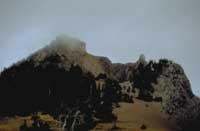
Inside the lake is the small island of Wizard on the western shore. In fact, it is the ash-shaded vertex of another volca, arising from the cataclysmic eruption that formed the giant caldera. The oldest trees on this island are about 800 years old and probably the volcanic cone did not appear much earlier on the surface of the lake. The island of Wizard seems nimí between the tempting walls of the lake, but rises 232 m above the water level.
In the surroundings of Crater Lake there are other amateur volcanoes and there are also beautiful traces of vulcanism. President Theodore Roosevelt named Crater Lake National Park in 1902, the sixth in the United States. Currently it covers 741,5 km2, that is, almost the area of Zuberoa. Every year half a million visitors approach Crater Lake. But, in addition to the beautiful corners the Crater Lake National Park has to show you, you can also learn about the history of America's national parks or, at least, it's perfect to illustrate a couple of ideas about it. Let's see it.
National parks and "utilitarian conservationism"
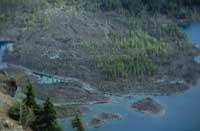
If we started making the history of Oregon's only national park, we could go a long way, and mention, for example, that 12,000 years ago there were human populations in their surroundings. Or approaching more recent times, the Indians of Klamath and Modoc have lived. Of course, the appearance of the first Europeans is much more recent, since it is usually located in 1853, where eleven miners were produced by chance. And it should not be said, immediately began the disputes between the natives and the newcomers, as had been seen in several films, and already established the fort Fort Klamath for 1863. From there it was a cataclysm for the Indians of both lineages, but we will not throw it on this occasion.
The
main soul and driving force of the park was William Gladstone Steel, who since 1886 worked for seventeen years in search of support for this vast and wonderful land of the Oregon Waterfalls, either through press articles, written letters, order extensions, etc. His intention was that the countless forests of the Oregon Waterfalls mountains were from the pastoralists' stoves to herd pastures, as well as getting rid of the attacks of the vasomutiles and miners. Thus, the main justification he used for the accession of forests to public property was that of water supply, as John Muir did in favor of Yosemite in California.
Steel then tried to support the Cascade Forest Reserve. This forest reserve proposed by Steel had a length of 480 km from the north to the south of Oregon, embracing almost completely the forest of the mountains of the State Waterfalls: 19,764 km2 in total. This reservation was proclaimed by President Grover Cleveland in 1893 and, of course, was seized by Crater Lake. Cascade Forest Reserve was the largest in the United States, but from the beginning it had its shepherds and its wood speculators. And a decade later, when President Roosevelt assigned him the category of National Park, the park only protected 645 km2, yes, around Crater Lake.
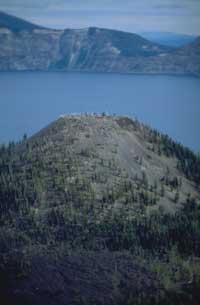
As is known, the driving force behind the demand for America's national parks at first was not an ecological-conservationist responsibility, but the cultural nationalism of the American era, and so, in this village without castles or cathedrals, Yellowstone, Yosemite, Grand Canyon, etc., were understood as "monuments" and no more. But this natural monumentalism was accompanied by an economic interest, with such a great balance. Or what is the same, the parks advanced, as monumentalism had no involvement with materialism.
In fact, there was a written policy that required nullity for the park's declaration. In cases where this condition was not met, that is, in areas of direct economic performance, it is usually delimited within the park and no more the minimum surface necessary to preside over the "monument".
And that's precisely what happened with Steel's large parking lot for Oregon's Crater Lake. In the dispute between monumentalism and materialism, the National Park almost exclusively paralyzed a delicious boiler, and the rest was applied a "utilitarian conservationism", without the total presumption of the National Park. That is, of Cascade Forest Reserve, a minority party became dependent on the National Park Service, and for the most part on the Forest Service of the Department of Agriculture.
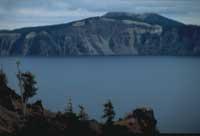
The National Park Service aims to maintain custody areas, while the Mountain Service manages its territories for diverse uses such as wood production, livestock, mining and leisure (Oregon has 225 state parks). However, it is not surprising that the forests of the Cascades are intensively exploited for the extraction of wood: 12.5 million m3 per year, the largest crop in the United States. However, and despite its scarce presence, the surface of the park has multiplied by two, in 1932 and 1980, with the aim of protecting some significant sections of the old forest.
Is there a natural sanctuary?
Since the eruption of Mount Mazama, about 600 plant species have colonized the Crater Lake National Park enclosure, forming dense coniferous forests. It is mainly a subalpine forest, almost 80% of the park, and a mountain fir (Tsuga mertensiana), a Douglas fir (Pseudotsuga taxifolia), a black pine (Pinus contorta), a western white pine (Pinus monticola), and a Engelmann spruce (Picea engelmanni very widespread). More than a dozen species of conifers inhabit clearly defined areas, depending on height, orientation and humidity. After the dark blue of the lake, the surrounding forests of conifers are the second sign of the park.
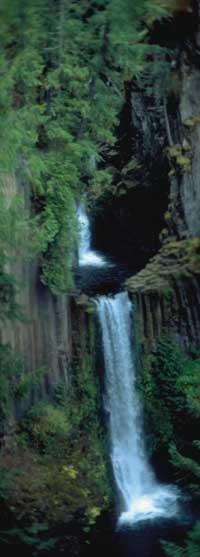
The predominance of conifers is clear, both inside the park and throughout the area, since the ecological conditions are favoured: high annual rainfall, dry soils in summer (due to three months of drought) and very cold winters.
On
the other hand, the leafy species that have reached the height of the park, apart from being scarce, present in most cases a shrubby aspect, forming a understory of open conifers and small bushes on the banks of the rivers.
As for animals,
the censuses carried out have focused mainly on vertebrates, so the data presented below do not refer to invertebrates. Directly using the number of species, these are: 52 species of mammals, 151 species of birds, four of reptiles, eight of amphibians and two of fish. That is, although usually only rocky squirrels and some birds are seen, the park is rich in fauna. But, of course, behind these absolute figures there are a wide variety of situations that we cannot analyze individually here. However, we will make some brushstrokes that we consider may be of interest.
For example, despite having mentioned two species of fish, Crater Lake had in principle no type of fish. William Gladstone Steel himself introduced the first rainbow trout in 1888, but they did not remain spontaneously until 1901. Later there have been trials of settlement of the lake with various species until 1941, but since then only live rainbow trout and kokanee salmon. Apparently, this difficulty in entering fish could be due to an extreme oligotrophy of the lake.
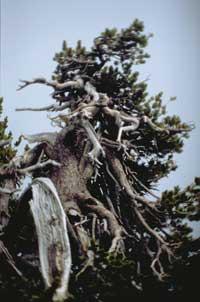
The black bear (Ursus americanus) is the largest carnivore in the park. The exact amount is not known, but is estimated to range from 30 to 40 individuals. That is, approximately one bear per twenty km2; for example, on the Pacific coast of Canada the density is 1 bear / 3,2-4,2 km2 in the case of the brown bear. However, this figure seems to be decreasing due to the decrease in habitat in the park area and the increase in bear hunting. This pressure outside the park is limiting the dispersion and has encouraged bears to look for the skyscraper, especially within the park. Surely the problem will worsen, since the bear is not a year-round resident more than a summer visitor.
Something similar happens with the Roosevelt deer (Cervus elaphus roosevelt), which in spring can count up to 150 individuals. It is a species spread throughout western Oregon, but that received the demasa hunt for meat. Thus, by 1880 the consequences of overexploitation were evident: there were no more deer in the whole area, but also cleaned of Crater Lake. Then, in an attempt to restore the Oregon Waterfall deer, hunting was completely banned and 15 deer from Yellowstone were transferred to Crater Lake in 1917. The restoration data are incomplete, especially from the early years, but the process has slowly been obtaining the current 150 deer. In any case, the management problems of the Crater Lake deer come mostly from the protection of a small part of the total annual distribution, that is, what usually happens in any small park. Outside of Crater Lake, the deer is, among others, a prized target of sport hunting.
Therefore,
like many parks, Crater Lake has become a natural sanctuary, being the last refuge for many species, the last ray of hope. In some cases this character is very clear, for example, the example of threatened and endangered species is more evident. So are the burusoil eagle, the peregrine falcon, the titaduna urubi, the wolf, the badger and the deer.
However, in the light of some studies, animal species (or rather some mammals, in particular)
are disappearing from the national parks of the United States, which, although extended along thousands of km2, are too small, that is, they can be understood as islands and, apparently, are governed by the standards of the biogeography of the islands. It is observed that large national parks have lost fewer species of mammals than small ones. In short, this question can be expressed as follows: in a national park the replica of fauna and flora of a very wide territory cannot be prescribed, since little by little the species will be caducando, without new colonizations that compensate for these local destructions.
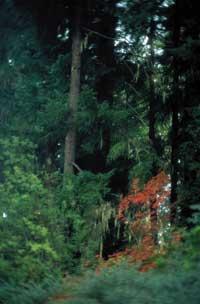
That is, there are no shrines of little breadth. In this sense, the mammals lost by Crater Lake are: river otter, armiño, mink and skunk. In these destruction sites of Crater Lake, or in more than forty cases observed in other parks, destruction does not seem to be a liver of human activity. Whatever the cause, it has been invisible; even, as has already been said, it can have something to do with the surface of the park, that is, with a small size.
There are no small natural sanctuaries. But, apart from living beings, in general the same can be said. In fact, deep research is underway at Crater Lake itself to determine whether the drilling of a geothermal company operating outside the park can move the boiler lake.
Buletina
Bidali zure helbide elektronikoa eta jaso asteroko buletina zure sarrera-ontzian











